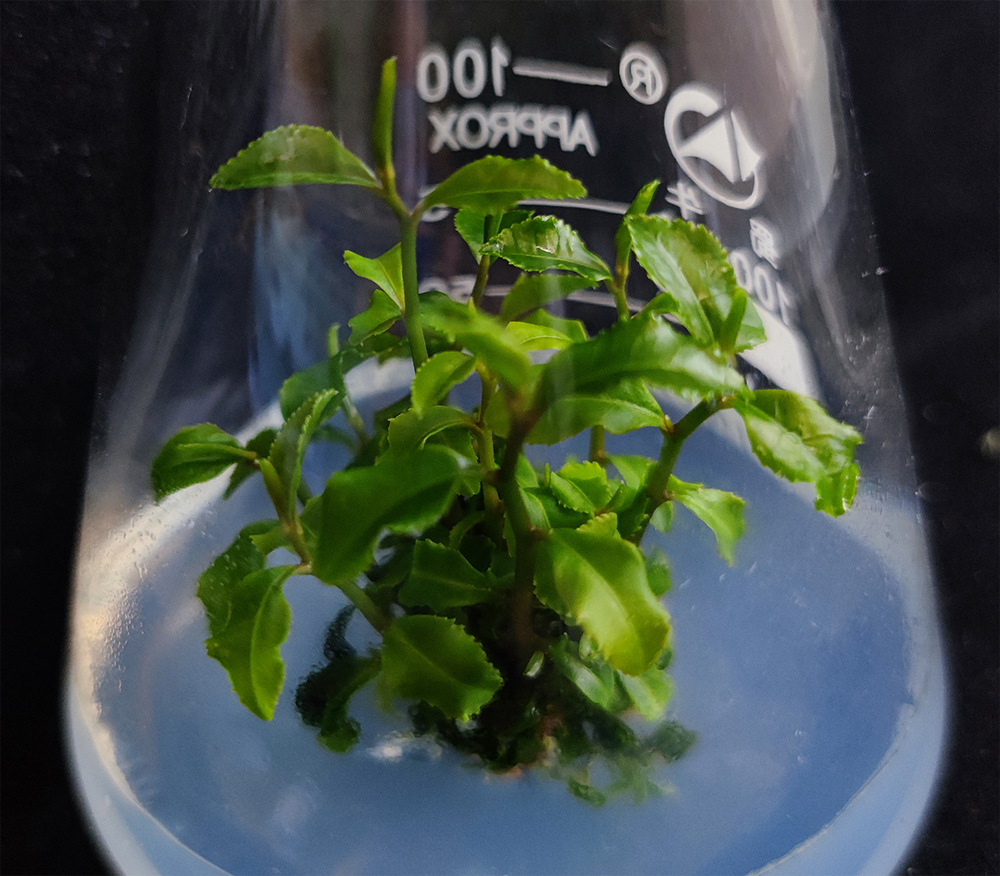

茶树茎段不定芽高效发生体系的建立
收稿日期: 2022-08-03
录用日期: 2022-11-15
网络出版日期: 2022-11-15
基金资助
“十三五”国家重点研发项目(2019YFD1001601);安徽省重大科技专项(202003a06020021)
An Efficient System for Regenerating Adventitious Buds in Stem Segments of Tea Plants
Received date: 2022-08-03
Accepted date: 2022-11-15
Online published: 2022-11-15
茶树(Camellia sinensis)是重要的经济作物, 杂合度高且变异度大, 其高效离体再生体系鲜见报道。以舒茶早茎段为起始外植体, 进行不定芽高效发生影响因子研究。结果表明, MS+2 mg∙L-1 6-BA为定芽诱导的最适配方, 定芽诱导率为84.44%, 吸收底盘膨大率为80%, 利于后续不定芽诱导; MS+2 mg∙L-1 6-BA+0.2 mg∙L-1 NAA+0.1 mg∙L-1 KT+1 mg∙L-1脯氨酸为不定芽增殖诱导的适宜配方, 不定芽诱导率为88.89%, 平均芽数为7.8。不定根诱导的适宜配方为1/2MS+3 mg∙L-1 IBA, 生根率为85.56%。采用RAPD和ISSR技术对再生植株进行分子检测, 在连续2代离体再生植株中未发现明显变异。

任露露, 张有泽, 黄克林, 宛晓春, 张照亮, 朱木兰, 韦朝领 . 茶树茎段不定芽高效发生体系的建立[J]. 植物学报, 2023 , 58(2) : 308 -315 . DOI: 10.11983/CBB22184
Tea plant is an important economic crop with high heterozygosity and variation. There are few reports on the in vitro regeneration system with high efficiency. In this study, the stem segment of a tea cultivar Shuchazao was used as the initial explants to identify the factors which could efficiently influence the regeneration of adventitious buds. The results showed that MS+2 mg∙L-1 6-BA was the best formula for normal buds induction, and the induction rate was 84.44%. The expansion rate of the absorption chassis was 80%, which was beneficial to the subsequent induction of adventitious buds. MS+2 mg∙L-1 6-BA+0.2 mg∙L-1 NAA+0.1 mg∙L-1 KT+1 mg∙L-1 proline was the suitable formula for the induction of adventitious buds, and the induction rate was 88.89%. The average number of shoots was 7.8. 1/2MS+3 mg∙L-1 IBA was the suitable formula for adventitious root induction, and the rooting rate was 85.56%. The regenerated plants were subjected to molecular verification by RAPD and ISSR techniques. The results showed that no significant variation was found in the two consecutive generations of regenerated plants in vitro.

| [1] | 陈立杰, 杨霞, 高倩, 李悦, 陈红 (2019). 花溪古茶树离体繁殖技术研究初报. 种业导刊 (8), 10-13. |
| [2] | 陈泽雄, 刘奕清, 黄登艳 (2009). ‘渝茶1号’离体培养及植株再生研究. 西南大学学报(自然科学版) 31(12),67-70. |
| [3] | 陈宗懋 (1994). 中国茶经. 上海: 上海文化出版社. pp. 5. |
| [4] | 陈祖枝 (2018). 福安茶树良种繁育现状及存在问题分析. 福建茶叶 40(2), 1-2. |
| [5] | 成浩, 曾建明, 周健, 王丽鸳, 常杰, 葛滢, 袁海波, 谷保静, 张小飞 (2007). 茶树种苗工厂化快速繁育技术. 茶叶科学 27, 231-235. |
| [6] | 李华锋, 滕杰, 莫岚, 曾雯, 晏嫦妤, 黄亚辉 (2016). 连南县茶树种质资源遗传多样性的RAPD分析. 茶叶学报 57, 166-171. |
| [7] | 李晓东, 向勤锃, 高吉刚, 张丽霞 (2010). 不同成熟度茶籽外植体诱导发生体胚的研究. 中国农学通报 26(18), 54-58. |
| [8] | 李旭云 (2020). 安溪县茶树种苗繁育及种质资源保护利用. 福建茶叶 42(11), 11-12. |
| [9] | 刘静 (2020). 茶树带腋芽茎段组织培养研究. 陕西农业科学 66(10), 43-45. |
| [10] | 刘青, 赵德刚, 赵懿琛 (2021). 古茶树种质资源遗传多样性ISSR分析. 种子 40(5), 7-14. |
| [11] | 罗军武, 施兆鹏, 沈程文, 刘春林, 龚志华, 黄意欢 (2004). 茶树种质资源遗传多样性的RAPD分析. 作物学报 30, 266-269. |
| [12] | 欧少云, 陈珊, 陈春兰, 刘细群 (2012). 不同外源激素对清远笔架茶愈伤组织诱导的影响. 湖北农业科学 51, 3626-3627. |
| [13] | 亓峥, 庞志强, 蓝增全 (2020). 云南小叶种茶树叶片和茎段愈伤组织诱导及继代培养. 科学技术与工程 20, 7206-7212. |
| [14] | 谭和平, 徐利远, 余桂蓉, 杜文平, 王宇星, 钟昌松 (2006). 茶树种质资源ISSR分子标记初步研究. 核农学报 20, 113-115. |
| [15] | 谢恩俊, 田维丽, 陈正武, 李岩, 赵德刚 (2020). ‘中黄1号’茶树带腋芽茎段组培快繁体系建立. 分子植物育种 18, 5071-5080. |
| [16] | 许益娟 (2012). 茶树组织培养再生体系优化与遗传转化的研究. 硕士论文. 南京: 南京农业大学. pp. 1-64. |
| [17] | 鄢东海, 刘声传, 罗显扬, 魏杰, 陆建良, 范方媛 (2015). 贵州地方茶树品种资源遗传多样性RAPD分析. 中国农学通报 31(19), 30-34. |
| [18] | 姚明哲, 黄海涛, 余继忠, 陈亮 (2005). ISSR在茶树品种分子鉴别和亲缘关系研究中的适用性分析. 茶叶科学 25, 153-157. |
| [19] | 岳翠男, 王治会, 江新凤, 杨普香 (2018). 茶树组培技术研究进展. 蚕桑茶叶通讯 2(3), 27-31. |
| [20] | Doyle JJ, Doyle JL (1987). A rapid DNA isolation procedure for small quantities of fresh leaf tissue. Phytochem Bull 19, 11-15. |
| [21] | Sun J, Lei PD, Zhang ZZ, Shi GH, Tang ZJ, Zhu SY, Jiang CJ, Wan XC (2012). Shoot basal ends as novel explants for in vitro plantlet regeneration in an elite clone of tea. J Hortic Sci Biotechnol 87, 71-76. |
/
| 〈 |
|
〉 |